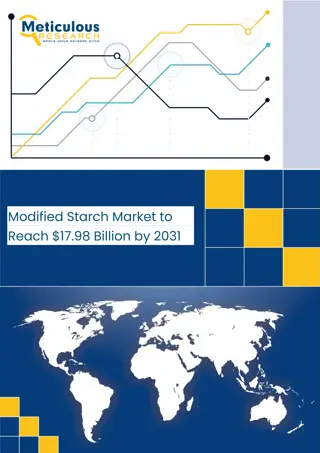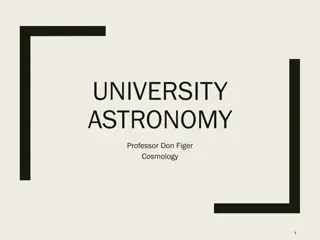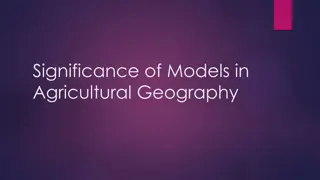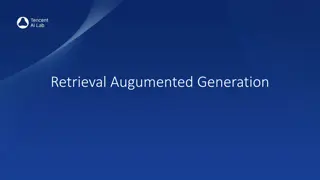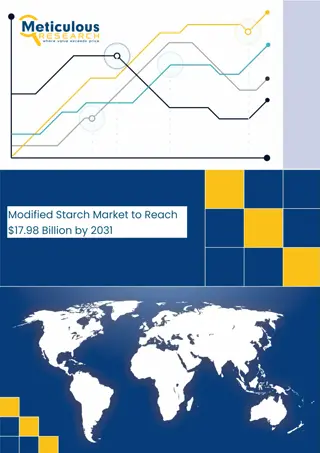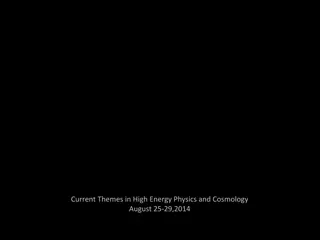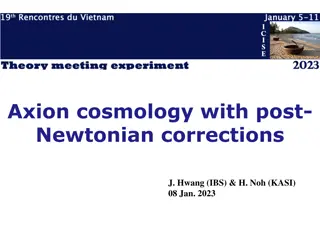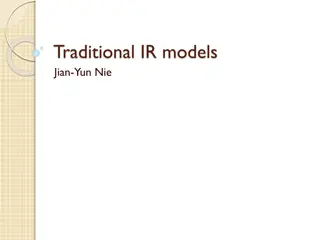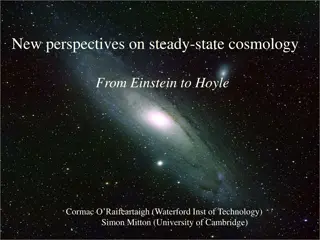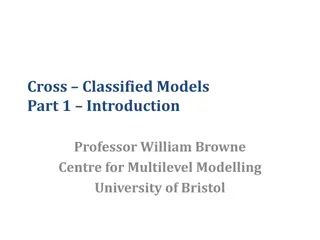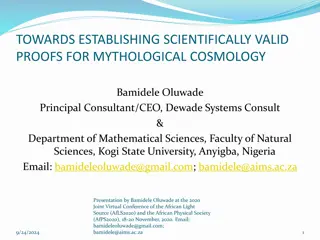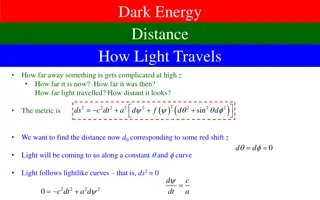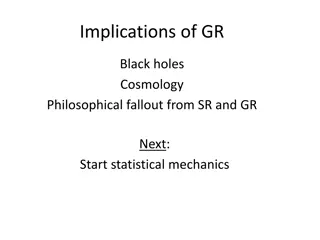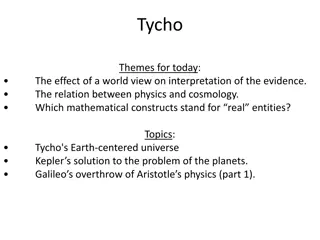Modified Cosmology Models from Thermodynamical Approach
The profound connection between thermodynamics and gravity in cosmological models, delving into black hole entropy, Friedmann equations, and the derivation of spacetime behavior from thermodynamic principles. Investigate the implications of modified gravity theories on the understanding of the universe's evolution.
Download Presentation

Please find below an Image/Link to download the presentation.
The content on the website is provided AS IS for your information and personal use only. It may not be sold, licensed, or shared on other websites without obtaining consent from the author.If you encounter any issues during the download, it is possible that the publisher has removed the file from their server.
You are allowed to download the files provided on this website for personal or commercial use, subject to the condition that they are used lawfully. All files are the property of their respective owners.
The content on the website is provided AS IS for your information and personal use only. It may not be sold, licensed, or shared on other websites without obtaining consent from the author.
E N D
Presentation Transcript
Modified Cosmology Models from Modified Cosmology Models from Thermodynamical Thermodynamical Approach Approach Jhih-Rong Lu (NTHU) Collaborators: C. Q. Geng, Y. T. Hsu, L. Yin Reference: arXiv: 1911.06046 [gr-qc] NCTS Dark Physics Workshop January 09-11, 2020 - NCTS, 3rd General Building, NTHU, Hsinchu, Taiwan
Outline Outline Introduction The Models Power Law Corrected Entropy Model (PLCE) Tsallis Entropy Cosmological Evolution Model (TECE) Numerical Results Summary
Introduction The Models Power Law Corrected Entropy Model (PLCE) Tsallis Entropy Cosmological Evolution Model (TECE) Numerical Results Summary
Thermodynamics and Gravity Thermodynamics and Gravity In 1972, J. Bekenstein suggested that black hole entropy should be proportional to its horizon area, i.e., ? ?. [J. D. Bekenstein, Lett. Nuovo Cimento 4, 737 (1972)] In 1973, Bardeen, Carter, and Hawking showed that black holes obey certain laws which bear a remarkable mathematical resemblance to laws of thermodynamics, e.g., ?? = 8???? + ????+ [Commun. math. Phys. 31, 161-170 (1973)] In 1975, Hawking further demonstrated that, in quantum theory, black holes emit Hawking radiation with a perfect thermal spectrum, i.e, ? = ?/2?. [Commun. Math. Phys. 43, 199 (1975)] ? Thus, we are able to identify entropy with horizon area, and determine the proportionality constant to be 1/4G, i.e., ? = 4?. Note: We use units of ? = = ??= 1. ?
Thermodynamics and Gravity Thermodynamics and Gravity In BH physics, the temperature and entropy are associated with the surface gravity and area of the horizon. [J. D. Bekenstein, Lett. Nuovo Cimento 4, 737 (1972) ; Comm. Math. Phys., Volume 31, Number 2 (1973), 161-170; Phys. Rev. D. 7.2333(1973); Comm. Math. Phys. 43, 199 (1975)] In 1995, T. Jacobson further showed that Einstein equation can be derived from the thermodynamic behavior of spacetime.[arXiv: gr-qc/9504004v2] In 2005, R. G. Cai and S. P. Kim demonstrated that the Friedmann equations can be derived from the first law of thermodynamics on the apparent horizon of the universe.[arXiv:gr-qc/0611071v2] Connection between thermodynamics and modified gravity theories (such as f(R) gravity, scalar-tensor theories, Gauss- Bonnet gravity ) has been widely investigated. [Ge, Phys. Lett. B 651, 49 (2007); Cai, Cao, Hu and Kim, Phys. Rev. D 78, 124012 (2008)]; Cai and Cao, Phys. Rev. D 75, 064008 (2007); Akbar and Cai, Phys. Lett. B 635, 7 (2006) ]
From First Law to From First Law to Friedmann R.-G. Cai and L.-M. Cao, Phys. Rev. D 75, 064008 (2007) Friedmann Equations Equations ? 4? S = ?? = ?? = ? ??+ ??? ???? & ?? = ??? together with the continuity equation: ??+ 3? ??+ ?? = 0 1 1 2. where ??= ?2+?/?2, ? = 2???, ? = 4??? ?2+? ?2=8?? ?? 3 ? ? ?2= 4??(??+ ??)
Introduction The Models Power Law Corrected Entropy Model (PLCE) Tsallis Entropy Cosmological Evolution Model (TECE) Numerical Results Summary
Power Law Correction Entropy (PLCE) Model 2(1 ???1 ? ? 2), ??=? 4?(? 2)/2 ???= 1. (4 ?)??2 ?,??= ?0 4 ?? ?2=8?? ??+ ??+ ???, 3 ? = 4?? ??+ ??+ ???+ ??+ ??+ ???, where 3 1 ??2 ??? 1 + ? ? ??2 ??? 1 + ???= 8??, 3 ??2 ??? 1 + . 8?? 1 8?? ???=
Tsallis Entropy Cosmological Evolution (TECE) Model ? 4 G?? ??= ?2=8?? ??+ ??+ ???, 3 ? = 4?? ??+ ??+ ???+ ??+ ??+ ???, where 3 ?? 2 ??2(1 ?)+ ?21 ???= 3, 8?? 1 8?? ? ? ??2 ??? 1 + 3 ??2 ??? 1 + , ???= ? 4?? 1 ? .
Introduction The Models Power Law Corrected Entropy Model (PLCE) Tsallis Entropy Cosmological Evolution Model (TECE) Numerical Results Summary
Numerical Results Numerical Results We use the CosmoMC program to perform the global fitting for the PLCE and TECE model. Dataset: CMB : Planck 2015 (TT, TE, EE, and lensing from SMICA) BAO : Baryon acoustic oscillation data from BOSS Weak lensing data from CFHTLenS H(z) data and ??8 data
2 1 ???1? ? ????:???= 2 4 ??
2 1 ???1? ? ????:???= 2 4 ?? 2 ?PLCE ? CDM = 3017.12; = 3018.32 2
? 2??, ????:??= with ? = 1,? = 1 + ? 4 ??
? 2?? ????:??= 4 ?? ?TECE ? CDM ? = 1,? = 1 + ? 2 = 3018.96; 2 = 3019.28
Summary Summary We compare the cosmological result of the two models with those of CDM. For PLCE model, we have obtained that ?PLCE ? CDM . For TECE model, we have a non-zero central value with a relaxed upper bound for total neutrino mass. Also, we have ?TECE < ? CDM 2 < 2 2 2 . Thanks For Your Attention! Thanks For Your Attention!
Power Law Corrected Entropy [Phys. Rev. Lett. 71 (1993) 666-669, Phys. Rev. D 77, 064013 (2008)] Black hole entropy, ???= ?/4?, can be associated with entanglement entropy. Consider a massless scalar field inside a spherical surface of radius ?. It can be shown that if the scalar field is in ground state, then the entanglement entropy will be ?~??? ???/?2 where ??? ???= 4??2 is the area of the sphere, and ? is the cutoff at the surface. [Phys. Rev. Lett. 71 (1993) 666-669] Thus, the black hole entropy can be regarded as a consequence of the entanglement of quantum fields across the horizon. If further consider the excited states together with the ground states, the entropy will be power-law corrected, i.e., ??? ??? ?2 1 + c ?2 064013 (2008)] ? ??? ??? ?~ ,c is constant.[Phys. Rev. D 77,
Tsallis Entropy[ [C. Tsallis, J. Statist. Phys. 52 C. Tsallis and L. J. L. Cirto, Eur. Phys. J. C 73 52, 479 (1988), 73, 2487 (2013)] ] In information theory, there are various ways to define entropy. More generalized version of entropy is, for example, Tsallis and Renyi. And of course, you can transform these types of entropy back to the Boltzman version. And the non-extensive property of Tsallis or Renyi seem to resemble with the area law of BH. So someone starts to investigate BH thermodynamics based on those types of entropy. And it was found that thermodynamic stability of BH differ from those of Boltzman entropy version.



![[PDF⚡READ❤ONLINE] Cosmology and Particle Astrophysics (Wiley-Praxis Series in As](/thumb/21627/pdf-read-online-cosmology-and-particle-astrophysics-wiley-praxis-series-in-as.jpg)



